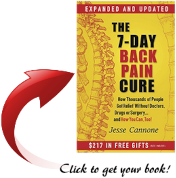Nope … not really. You see, neck pain is much more common than you think. Really? Yup, really. Neck pain, sometimes referred to as cervical pain, happens to over 60% of us during our life. Neck pain normally can be felt from the top of the shoulder all the way up to the base of the head. Neck pain disappears naturally in a short time for most individuals, however, some may experience chronic neck pain.
The neck, which is an extension of your spine, consists of 7 bony vertebrae, which are small bone segments that look like this …

The top vertebra is called the Atlas. The function of the Atlas is to keep the head stable as it connects the spine and skull. The next vertebra down is known as the Axis. And as you can determine from its name, it provides for the rotation movement of the head. Unlike the back, which is protected by thick muscles, the neck is not that heavily protected. However, the neck is much more flexible, in terms of movement, than the back. And that being said, it is vulnerable to injury and pain. Neck pain could originate from the head, jaw, shoulders or other areas in close proximity to your neck.
In general, neck pain is due to the strain on the muscles, caused by frequent overuse such as prolonged or repeated activities. This can result in neck joint swelling, unpleasant muscle spasms in the neck, strain from ligament tissue wrenching, or neck strain from an overstretched muscular tissue. Cervical disc conditions and arthritis could likewise cause the neck discomfort.
Some factors that can easily trigger neck pain are:
- Bad posture
- Stress and worry
- Sleeping in a uncomfortable position
- Playing online video games for hours in a hunched over position
- Working on the computer keyboard for a long duration
- Painting your home’s ceiling
- Remaining in one position for a long of time
- Whiplash

Before you start looking for cures and treatments on your own, it may be a good idea to consult a medical professional if your neck pain has been plaguing you for weeks. A proper medical diagnosis is your first step toward treatment and recovery. Once a diagnosis has been made, consult with your doctor about the treatments that are available for your neck pain.



